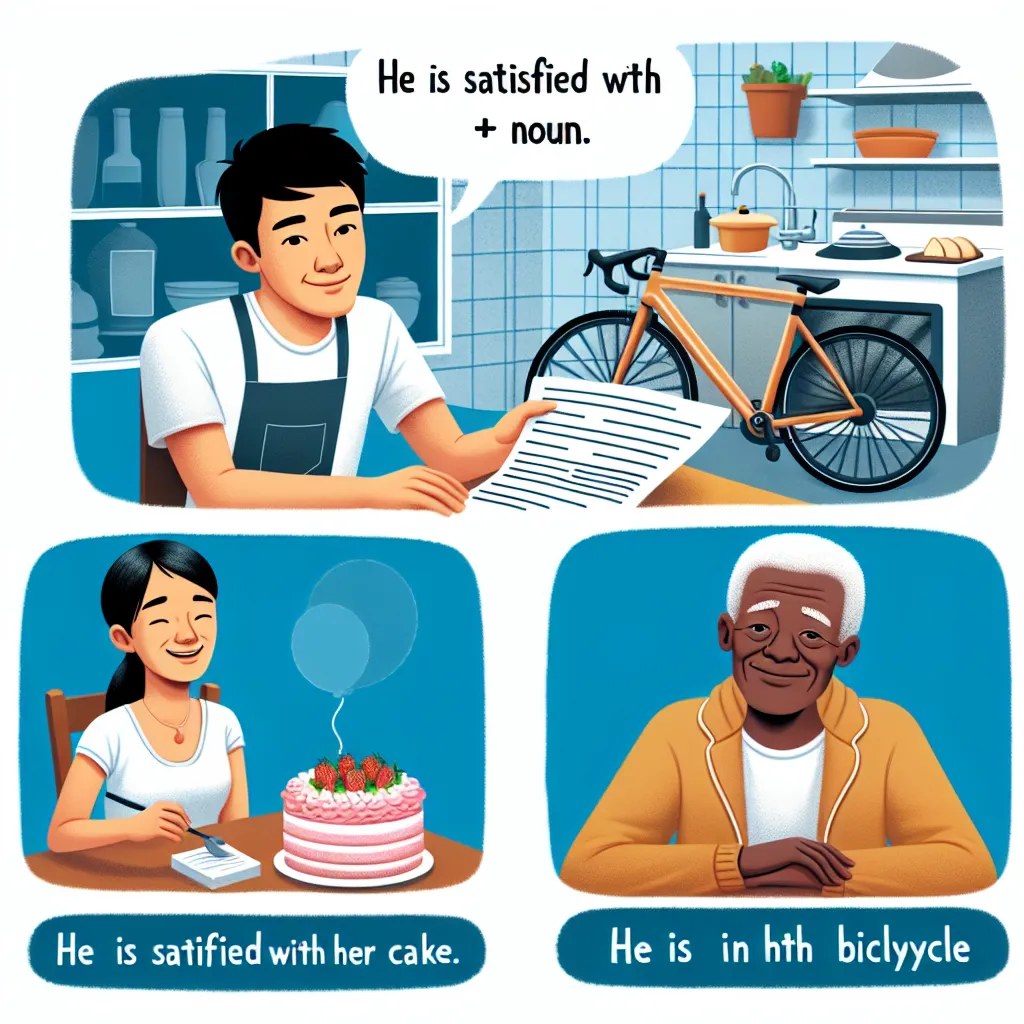The phrase “be satisfied with + noun” is a common expression used to convey contentment or approval with something. In the context of IELTS, understanding and using this structure correctly can help you express your ideas more clearly and accurately, potentially boosting your score in both the writing and speaking sections.

Understanding the Structure and Its Importance in IELTS
The structure “be satisfied with + noun” consists of three main components:
- A form of the verb “to be” (am, is, are, was, were)
- The adjective “satisfied”
- The preposition “with”
- A noun or noun phrase
This structure is frequently used in IELTS tasks, particularly in Writing Task 2 and Speaking Parts 2 and 3, where candidates are often required to express opinions or discuss personal experiences.
Grammar Formula
[Subject] + [be verb] + satisfied + with + [noun/noun phrase]
Understanding this formula is crucial for using the structure correctly in your IELTS responses.
Examples and Usage in IELTS
Let’s explore some examples of how you can use this structure in different parts of the IELTS test:
-
Writing Task 2:
“Many people are satisfied with their current living conditions, while others strive for continuous improvement.”This sentence could be used in an essay discussing lifestyle choices or societal attitudes.
-
Speaking Part 2:
“I was very satisfied with my performance in the school play. The audience’s reaction made me feel proud of my hard work.”This example shows how you can use the structure to describe a personal experience in detail.
-
Speaking Part 3:
“In my opinion, employers should ensure that their staff are satisfied with their work environment to boost productivity.”Here, the structure is used to express an opinion on a workplace-related topic.
-
Writing Task 1:
“The survey results show that 75% of respondents were satisfied with the new public transport system.”This sentence demonstrates how you can use the structure to describe data in a report.
-
Speaking Part 1:
“I’m generally satisfied with my daily routine, but I’m always looking for ways to improve it.”This response shows how you can use the structure to answer a question about your lifestyle.
Advanced Usage for Higher Band Scores
To aim for higher band scores in IELTS, consider these advanced uses of the structure:
-
Modifying the intensity:
- “I am completely satisfied with the outcome of the project.”
- “She was barely satisfied with her exam results.”
-
Using synonyms:
- “The customers were content with the service provided.”
- “We felt pleased with the progress made so far.”
-
Negative forms:
- “They were not satisfied with the proposed solution.”
- “I am far from satisfied with my current job.”
-
Question forms:
- “Are you satisfied with your current living situation?”
- “How satisfied were you with the training program?”
-
Comparative structures:
- “I am more satisfied with my new job than I was with my previous one.”
- “She seems less satisfied with her results compared to last year.”
Using these variations can demonstrate a higher level of language proficiency and help you achieve a better score in the IELTS test.
Common Mistakes to Avoid
When using “be satisfied with + noun,” be careful to avoid these common errors:
-
Incorrect preposition:
- Incorrect: “I am satisfied
ofmy progress.” - Correct: “I am satisfied with my progress.”
- Incorrect: “I am satisfied
-
Confusing ‘satisfy’ and ‘satisfied’:
- Incorrect: “The manager was
satisfywith the report.” - Correct: “The manager was satisfied with the report.”
- Incorrect: “The manager was
-
Forgetting the preposition:
- Incorrect: “We were satisfied
the service.” - Correct: “We were satisfied with the service.”
- Incorrect: “We were satisfied
-
Using an adjective instead of a noun:
- Incorrect: “They are satisfied with
comfortable.” - Correct: “They are satisfied with the comfort of their new home.”
- Incorrect: “They are satisfied with
-
Incorrect verb form:
- Incorrect: “She
satisfieswith her job.” - Correct: “She is satisfied with her job.”
- Incorrect: “She
By avoiding these mistakes, you can ensure that your use of this structure is accurate and effective in your IELTS responses.
Conclusion
Mastering the “be satisfied with + noun” structure can significantly enhance your IELTS performance. It allows you to express contentment, approval, or satisfaction accurately and naturally. Remember to practice using this structure in various contexts, such as describing personal experiences, discussing social issues, or analyzing data. By incorporating this phrase and its variations into your language repertoire, you’ll be better equipped to tackle a wide range of IELTS topics and achieve a higher band score.
To further improve your skills, try using this structure in practice essays or speaking exercises. You might encounter topics like job satisfaction, educational experiences, or consumer behavior where this phrase would be particularly relevant. Keep practicing, and you’ll find yourself using “be satisfied with + noun” with confidence in your IELTS test!